
39 minute read
TF&G Report + HotShots




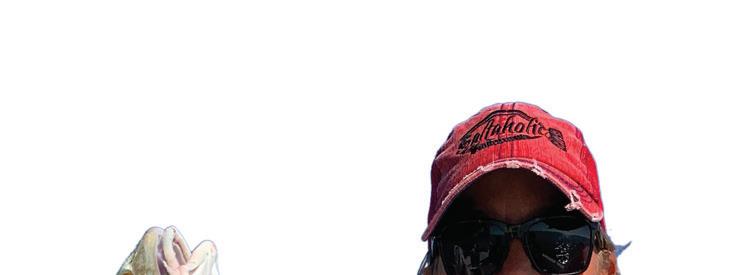

Program Ensures Poachers Will Pay
also develop template legislation that could be ers o en get away with li le penalty. is carried in state houses to help state agencies emboldens them and other poachers to steal ght wildlife crime. our public trust resources–and potentially the B&C also announced that it is actively future of hunting.” DURING THE ANNUAL MEETING OF seeking additional sponsorship from the out- In 2016, the Boone and Crocke Club the National Assembly of Sportsmen’s Cau- door industry and other organizations to help conducted research on the state restitution cuses (NASC), the Boone and Crocke Club fund Poach & Pay research and outreach in systems for illegal take of big game species announced its plans to lead a long-term Poach the coming years. through Phase I of the Poach & Pay project. & Pay campaign against poaching. Boone and Crocke Club President is review found that 42 states currently rough Poach & Pay, the club will work Timothy C. Brady noted “Poaching goes have restitution programs—many include trowith state wildlife agencies, legislators, and the against all that we hold sacred as law-abiding phy restitution—however there is li le apparjudicial system to improve the detection and sportsmen and women and undermines the ent standardization of restitution costs, either conviction of poachers and to ensure that the entire foundation of the North American within or among states. nes being assessed for this illegal killing are in Model of Wildlife Conservation. However, Surveyed state conservation o cers line with the value society places on wildlife. the media o en uses the terms hunting and believed that poaching penalties accurately
Poach & Pay has received initial nancial poaching interchangeably, dragging all hunt- re ect the crime and current values of illegally support through Bass Pro Shops and Cabela’s ers down with the crimes of poachers. taken animals. However, the survey found Outdoor Fund. e program will include “In addition, with li le consistency among that the judicial system detailed research and a public outreach detailed research and a public outreach states in terms of nes and restitution, poachstates in terms of nes and restitution, poach- o en was the primary campaign to actively engage the campaign to actively engage the obstacle in convicting sportsmens’ community sportsmens’ community and punishing against poaching. Poach & against poaching. Poach & poachers. Pay will Pay will In fact,
poaching interchangeably, dragging all hunt- re ect the crime and current values of illegally ers down with the crimes of poachers. taken animals. However, the survey found
“In addition, with li le consistency among that the judicial system o en was the primary obstacle in convicting and punishing poachers. In fact,


MIXED STRINGER RED SNAPPER

Aransas Pass Port Mansfi eld
Nina Garrett caught a limit of reds plus this nice trout on a recent wadefi shing trip around Mud Island near Aransas Pass and Rockport. To top off the day, their boatride back was escorted by a pod of dolphins that stayed with them for 20 minutes. Carlos Marcel Gamboa landed this snapper fi shing out of Port Mansfi eld with Big Dawg Outfi tters. The fi ght only took three minutes. It was Carlos’s fi rst red snapper.
wildlife cases are disproportionately dismissed, and penalties are o en applied inconsistently. is suggests that there is a lack of understanding of wildlife laws and the perception that poaching is a victimless crime.
“As responsible sportsmen and women, we must do all we can to prevent wildlife crime and preserve the integrity of hunting,” said Bob Ziehmer, Senior Director of Conservation at Bass Pro Shops and Cabela’s.
“We thank our customers who, by rounding up purchases in our stores and online in support of the Outdoor Fund, are directly contributing to the ght against poachers through the Boone and Crocke Club’s Poach & Pay project.” e next phase of the Poach & Pay research will be conducted by Dr. Kristie Blevins and Dr. Jonathan Gasse with the Wildlife Management Institute. As a criminologist (Blevins) and a former director of a state wildlife agency (Gasse ), they are uniquely positioned to lead the Poach & Pay research. eir investigation will assess the barriers to prosecuting wildlife crime, evaluate the detection rate and conservation impacts of wildlife crime, describe the motivational factors and potential deterrents that in uence poachers, and provide solutions to improving prosecution and conviction rates, as well as a defensible framework for poaching penalties.
“ e Poach & Pay research will be the largest, most extensive study on poaching that has ever been done in North America,” commented Gasse .
“ e rst component of the research will focus on trying to get a handle on the ‘dark gure’ of wildlife crime – the amount of poaching that occurs that goes undetected. We reviewed statewide wildlife crime citation and court data in Kentucky from 2006 to 2017 to evaluate the real cost of illegal take violations and restitution and nes in the state.
Previous studies on deer poaching have estimated that the detection rate is only around two percent. is suggests that 98 percent of wildlife crimes may go undetected, and the real cost of undetected crimes to Kentucky may approach $43 million annually.” e research conducted through Poach & Pay will be the rst of its kind to use modern statistical, scienti c, and sociological methodology to describe the complex issue of poaching and other wildlife crimes in North America.
More important, the Boone and Crocke Club will develop justi able recommendations for reducing o enses by a acking the motivations for commi ing those crimes. With the information gathered through the research, the Club plans to work with our partners to reduce the barriers to the prosecution and conviction of poachers, as well as increase the penalties for poaching to deter the crime.
In addition, the Poach & Pay outreach campaign will arm U.S. sportsmen and women with real poaching data that clearly separates poaching from hunting.
CONTINUED FROM PAGE 32
He was shot by a young Oglala brave named White Cow Bull, with a Sharps buffalo ri e. A Cheyenne war chief named Two Moon claimed to have killed Custer later. A er taking Custer’s handgun away from him in desperate hand-to-hand combat, he shot Custer in the head with Custer’s own revolver. at is the story of just a few of the weapons known to have been used at the Li le Big Horn. e complete collection numbers more than 150 weapons and artifacts. e collection names the warriors who owned them, and in some cases where the weapons were obtained and from whom. is subject could be the study of volumes, not just a short piece in a magazine. e Native Americans were very good, and very truthful, in passing down oral histories of the ba le —and the weapons used there and taken as booty. e facts contained herein are not completely indisputable, but if I did not believe them to be true, I would not have included them. You study the subject and reach your own conclusions, but rst nd a copy Wendell Grangaard’s book, Documenting the Weapons Used at the Li le Big Horn, by Mariah Press. In it you can read of Black Elk, Kills Two, Crow King, Rain in the Face, Gall, and others.
Anpétu wăsté (Lakota greeting, “good day”).
—Staff Reports





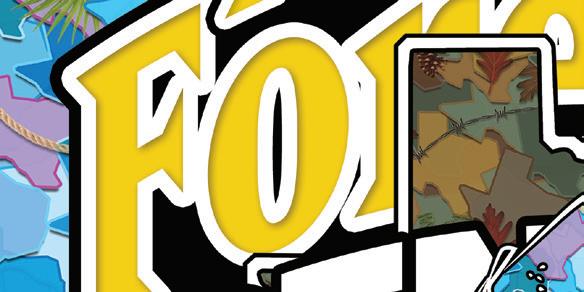


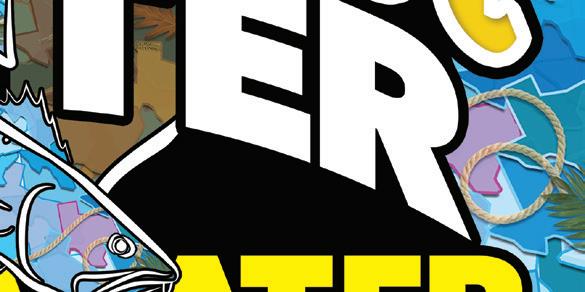
Spring Brings Fishing Action to a Slow Boil

Reported by CAPT. EDDIE HERNANDEZ
WITH THE SPRING SEAson slowly but surely beginning to take hold of the Texas Gulf Coast, warmer air and water temperatures are gradually becoming the rule rather than the exception. e arrival of the early spring months gives anglers across the state more and more opportunities for targeting trout, red sh and ounders. ose of us who sh the upper coast are no longer limited to the main lake or other areas north of the ship channel. rough the grapevine we are hearing sporadic reports of nice stringers from the je ies and up and down the ship channel. On Sabine, the shoreline from Cheniere to the old je ies is some of the best real estate on the entire coast. Its bo om contour is made up of a perfect blend of sand, mud, shell and riprap which provides plenty of protection for bait sh.
Trout, red sh and ounders move onto the shallow shorelines in the channels of Galveston and Sabine in pursuit of the abundant forage. ere they will stu themselves full of mullet, shad, shrimp and crab. Keeping the boat in about seven feet of water and fan casting parallel with and toward the bank should present the most opportunity for strikes. e early morning topwater bite is good and will continue to progress through early spring. If you sh the tail end of an incoming tide or a nice outgoing tide you should be in business. Walking the Dog in two to ve feet of water with big, loud topwater plugs such as She Dogs and Super Spooks should really get their a ention. So plastics rigged with 1/4 ounce lead heads will also produce good results.
Trout, reds and ounders will feed aggressively when the spring tides push the green water into the channel and will gladly accept o erings such as H & H Cocahoe Minnows, Down South Lures, Assassins and Zoom Super Flukes. Great colors are limetreuse, glow, pumpkin and chartreuse.
High percentage areas in the bays should be on the protected shorelines if you’ve got some tidal help and decent water. Key on areas that are near the mouths of cuts, drains or bayous. Hungry trout and red sh will cruise these areas looking for an easy meal as the bait sh go with the ow of the tide.
Flounders will also stack up here and use various areas for ambush points. As big numbers of these tasty at sh continue making their way back into the bays, the ounder bite should continue gaining momentum for the next few months.
Slowly dragging mud minnows or nger mullet has always been a great option, but curl tail grubs like Gulp Swimming Mullet and others tipped with fresh dead shrimp will also get serious results.
CAPT. HERNANDEZ ContactUs@Fishgame.com
UPPER COAST HOTSPOTS
LOCATION: Bastrop Bay HOTSPOT: Bastrop Bay Shell GPS: N 29 6.0005, W 95 10.0045 (29.1000, -95.1667)
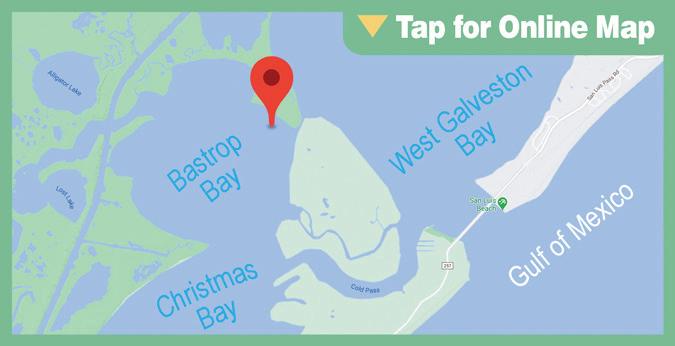
SPECIES: Redfi sh BEST BAITS: Norton Soft Plastics SOURCE: Capt. Greg Brewer 832-435-3020 TIPS: A lot of times the redfi sh will start feeding in the afternoon as the glass minnows start moving in. It’s usually a big feed up to sundown.
LOCATION: Galveston East Bay HOTSPOT: Anahuac Refuge Flats
5 7
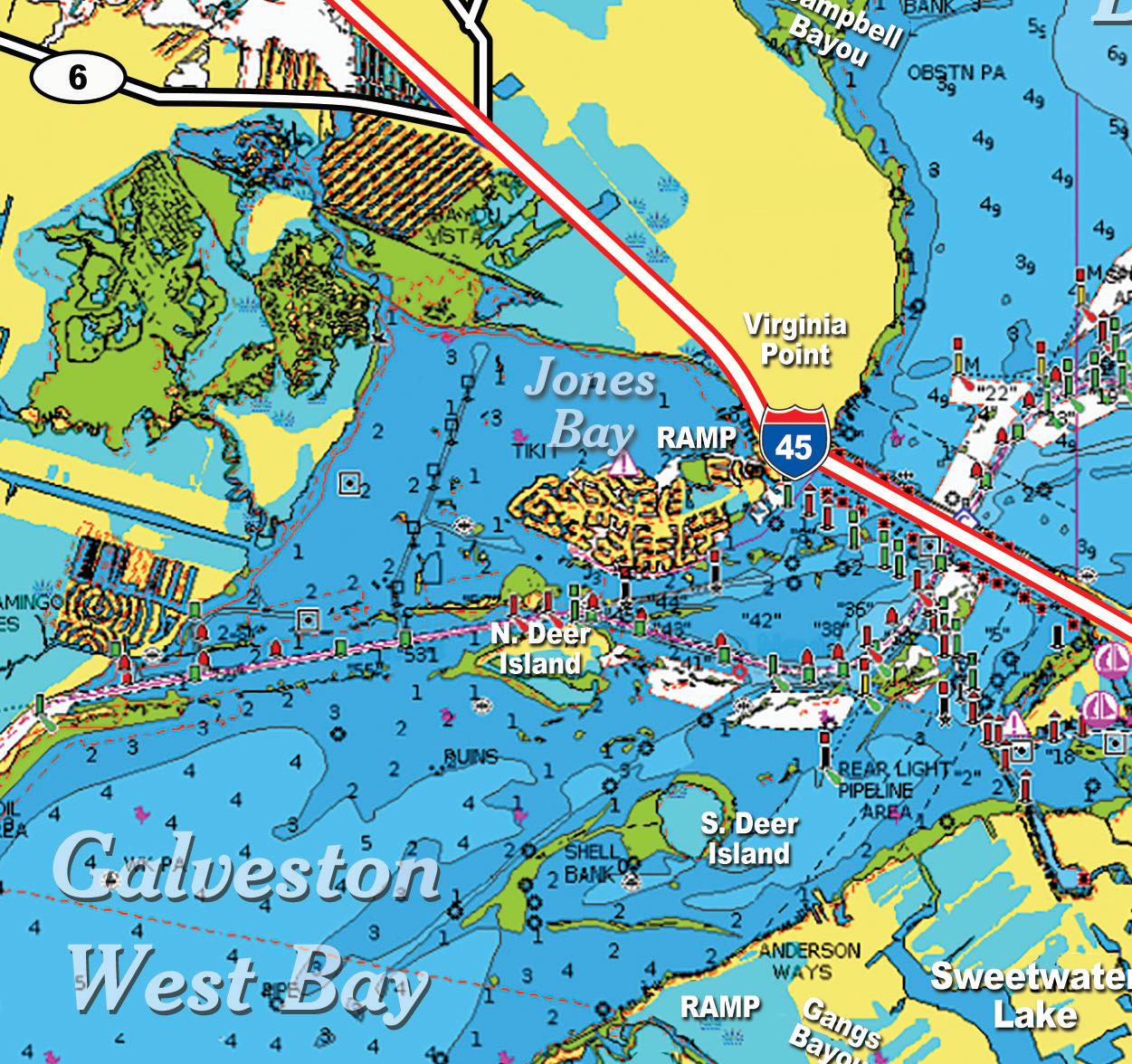
1
2 1
9
6 8 10
2
3 4 3
4
UPPER WEST BAY
WEST GALVESTON BAY is a long inlet of Galveston Bay in Galveston and Brazoria counties that nearly runs the length west of Galveston Island. The upper end of West Bay is bounded by the Galveston Causeway, where West Bay joins the southwest end of Galveston Bay. At this end of the bay is an extension, Jones Bay, on the north shore and several bayous, including Offats Bayou on the south shoreline. Selected HOTSPOTS are shown in the table below, and on the map.
SPECKLED TROUT
KEY HOTSPOT NAME GPS BEST BAIT & TACTIC 1 Jones Bay Shoreline N 29 18.684, W 94 55.555 Live Croaker, shrimp, fi sh grass & cast to sandpockets; Oct-Apr, avoid midday
2 North Deer Island
N 29 16.964, W 94 56.223
3 Confederate Reef
N 29 15.755, W 94 55.177
4 Anderson Ways
N 29 15.962, W 94 53.948
REDFISH
5 Jones Bay Shoreline N 29 18.525, W 94 56.406
6 West Bay Shell
N 29 16.363, W 94 54.582
FLOUNDER
7 Jones Bay Shoreline N 29 18.670, W 94 55.652
Live Croaker, shrimp, fi sh grass & cast to sandpockets; Oct-Apr, avoid midday Live Croaker, shrimp under cork, drift reef edge; FebJun, Sep-Nov, avoid midday Live Croaker, shrimp, drift while working color changes; Spring, Fall, avoid midday
Live shrimp under cork short leader, work grass points; all year, dawn-am, aftn-dusk Kelly Wiggler soft plastics, shrimp. Key on slicks.; All year; Early, Midday
Live mud minnows, work grass and points; Oct-Dec, dawn thru dusk
8 Railroad Bridge SHEEPSHEAD
9 Tiki Island
N 29 17.664, W 94 52.651
N 29 17.664, W 94 52.651
Red/white Flounder Pounder, must have moving tide; Sep-Nov, avoid night
Live or dead shrimp under cork, work close to pilings; all year, all day
10 Railroad Bridge
N 29 17.487, W 94 54.883
Live or dead shrimp under cor, work close to structure; all year, all day
WADEFISHING
1 North Deer Island
2 Teichman Point
3 Anderson Ways
N 29 17.301, W 94 55.776 N 29 16.798, W 94 52.952 N 29 15.921, W 94 54.067
Trout, Corkys & live croaker, fi sh the drops, sight cast; November thru February Trout, topwaters & spoons, fi sh with a moving tide; May thru August Trout, topwaters, fi sh the drops and sand holes; March thru May
4 Gangs Bayou
N 29 15.565, W 94 54.950
Trout, reds, fl ounder; shrimp under cork, fi sh dropoffs; Mar-Jun, Sep-Oct; avoid midday, night
SOURCE: TEXAS LAKES & BAYS FISHING ATLAS 2020 GPS: N 29 33.804, W 94 32.374 (29.5634-94.5396)

SPECIES: Redfi sh Best Bait: Live and artifi cial redfi sh bait SOURCE: Texas Lakes & Bays Fishing Atlas Fishgame.com/fi shandgamegear TIPS: Wade near grass, casting to mullet pods and shad; Spring, Fall, avoid midday, night
LOCATION: Galveston East Bay HOTSPOT: Anahuac Wildlife Refuge GPS: N 29 33.573, W 94 32.266 (29.5596-94.5378)

SPECIES: Flounder Best Bait: Mud minnows, shrimp SOURCE: Texas Lakes & Bays Fishing Atlas Fishgame.com/fi shandgamegear TIPS: Fish shoreline, wade; dawn-afternoon
LOCATION: Galveston East Bay HOTSPOT: Big Pasture Bayou GPS: N 29 30.322, W 94 35.78 (29.5054-94.5963)

SPECIES: Redfi sh Best Bait: Live and artifi cial redfi sh bait SOURCE: Texas Lakes & Bays Fishing Atlas Fishgame.com/fi shandgamegear TIPS: Best with outgoing tide, drift back cove forward to mouth; avoid midday, night
LOCATION: Galveston East Bay HOTSPOT: Hanna’s Reef GPS: N 29 28.703, W 94 45.703 (29.4784-94.7617)
UPPER COAST

SPECIES: Speckled Trout Best Bait: Live and artifi cial trout bait SOURCE: Texas Lakes & Bays Fishing Atlas Fishgame.com/fi shandgamegear TIPS: Drift/anchor with moving tide, low wind; avoid midday, night
LOCATION: Galveston East Bay HOTSPOT: Ving-et-un GPS: N 29 32.92, W 94 46.419 (29.5487-94.7737)
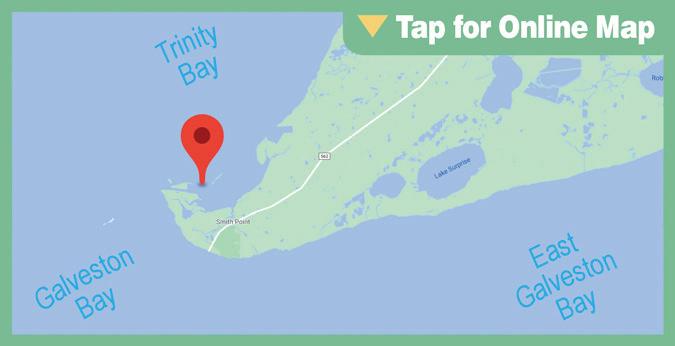
SPECIES: Flounder Best Bait: Live mud minnows, soft plastics SOURCE: Texas Lakes & Bays Fishing Atlas Fishgame.com/fi shandgamegear TIPS: Wade or drift slowly; avoid midday
LOCATION: Galveston Jetties HOTSPOT: North Jetty GPS: N 29 21.0045, W 94 43.0015 (29.3501, -94.7167)

SPECIES: Speckled Trout BEST BAITS: Soft Plastics, Corkys or Topwaters SOURCE: Capt. Mike Williams 713-256-9260 TIPS: The last 30 minutes of the day, any day, is the best time because most of the time that’s when the water is going to be the warmest.
LOCATION: Galveston Trinity Bay HOTSPOT: Camp House GPS: N 29 46.171, W 94 45.232 (29.7695-94.7539)

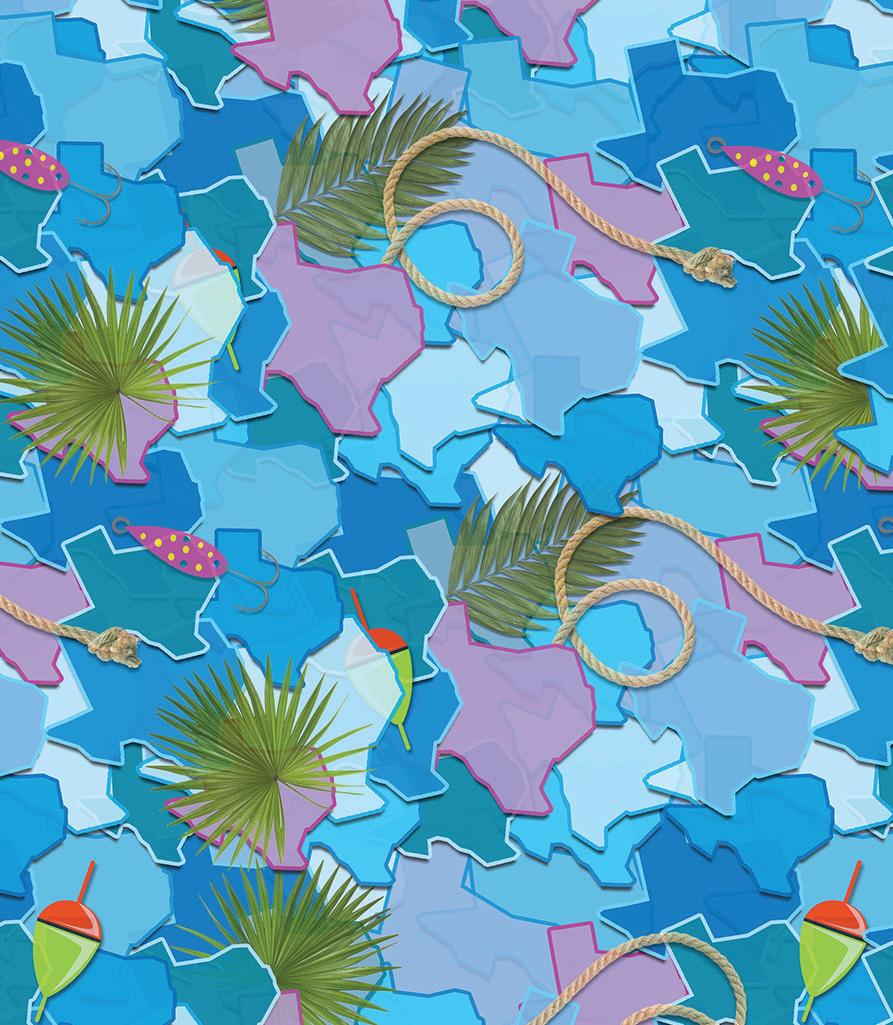

SPECIES: Speckled Trout Best Bait: Suspending twitch baits SOURCE: Texas Lakes & Bays Fishing Atlas Fishgame.com/fi shandgamegear TIPS: Wade shallow early, drift later morning.
LOCATION: Galveston Trinity Bay HOTSPOT: Halfway Reef GPS: N 29 33.406, W 94 58.207 (29.5568-94.9701)

SPECIES: Redfi sh Best Bait: Live shrimp SOURCE: Texas Lakes & Bays Fishing Atlas Fishgame.com/fi shandgamegear TIPS: Fish shrimp 2-3 feet under popping cork, anchor or drift; dawn through afternoon
LOCATION: Galveston Trinity Bay HOTSPOT: Lone Oak Cove GPS: N 29 36.702, W 94 42.892 (29.6117-94.7149) SOURCE: Texas Lakes & Bays Fishing Atlas Fishgame.com/fi shandgamegear TIPS: Wade or drift slowly; avoid midday
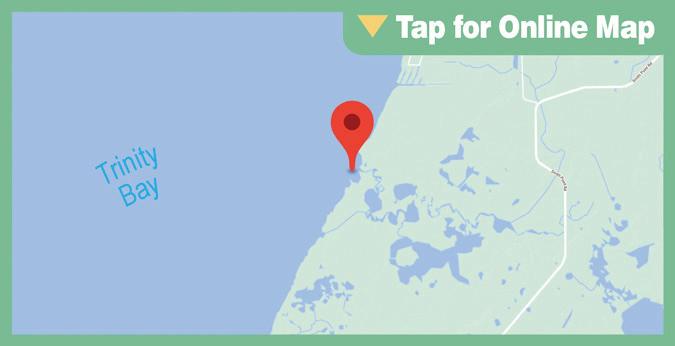
LOCATION: Galveston Trinity Bay HOTSPOT: Trinity Bay Wreck GPS: N 29 40.871, W 94 45.409 (29.6812-94.7568)

SPECIES: Speckled Trout Best Bait: Live croaker, shrimp SOURCE: Texas Lakes & Bays Fishing Atlas Fishgame.com/fi shandgamegear TIPS: Fish the rocks, best with tides; all day
LOCATION: Galveston West Bay HOTSPOT: Carancahua Cove GPS: N 29 12.3312, W 94 58.6619 (29.2055, -94.9777)

SPECIES: Speckled trout BEST BAITS: 5” soft plastics baits SOURCE: Capt. Paul Marcaccio 281-788-4041 TIPS: The shorter paddle tail baits don’t work at this time of the year.
LOCATION: Matagorda Bay HOTSPOT: Middle Ground GPS: N 28 31.727, W 96 11.620 (28.528777, -96.193661)
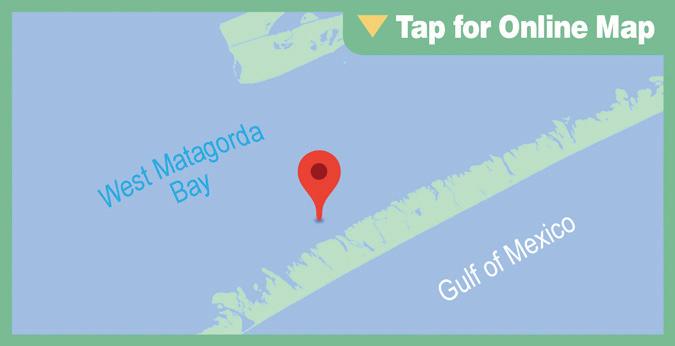
SPECIES: Redfi sh BEST BAITS: Norton Bull Minnow or Lit’l Fishie SOURCE: Capt. Tommy Countz 281-450-4037 TIPS: Concentrate on the guts coming out of the
peninsula while throwing 1/8-ounce lead head or a weedless gold spoon.
LOCATION: Matagorda East Bay HOTSPOT: Cleveland Reef GPS: N 28 39.8329, W 95 51.7009 (28.6639, -95.8617)

SPECIES: Speckled Trout BEST BAITS: Smaller Corky soft body SOURCE: Capt. Van Critendon 361-648-1886 TIPS: Favorite colors are pink and pearl.
LOCATION: Matagorda East Bay HOTSPOT: Kilbride Reef GPS: N 28 43.416, W 95 49.992 (28.7236, -95.8332)

SPECIES: Speckled Trout BEST BAITS: DOA Soft Plastics SOURCE: Capt. Van Critendon 361-648-1886 TIPS: Freeline a soft plastic with a jig head. On others we will use a popping cork with about an 18-inch leader under the cork.
LOCATION: Palacios HOTSPOT: South Shoreline GPS: N 28 33.0649, W 96 8.7769 (28.5511, -96.1463)

SPECIES: Speckled Trout BEST BAITS: Smaller Corky soft body SOURCE: Capt. Van Critendon 361-648-1886 TIPS: Favorite Corky colors are pink and pearl. LOCATION: Sabine Lake HOTSPOT: Blacks Bayou GPS: N 29 59.866, W 93 45.1819 (29.9978, -93.7530) SPECIES: Redfish BEST BAITS: Corky, Corky Devil SOURCE: Capt. Bill Watkins 409-673-9211 4097862018@sbcglobal.net www.fishsabinelake.com TIPS: If the water temps drop below 50 degrees, shift from soft plastics to the Corky.


A Dose of Daylight Spurs Spring Specks

SAN ANTONIO BAY AREA
Reported by CAPT. CHRIS MARTIN
THE SPRING PATTERN FOR Texas speckled trout begins in March and April, but is dependent on water temperatures and sun-
light.
Conditions that spur the spring pattern include water temps in the 60s and a li le more daylight with each passing day. Di erent weather scenarios, such as cold fronts, can also have an in uence on the spring pa ern.
As a frontal passage blows across the coast, water levels drop, temperatures cool, water clarity darkens, and clear skies follow. ese frontal changes cause the trout to react accordingly.
One key thing you should pay close a ention to is light conditions. e amount of light present in the water is a huge in uence on how the sh eat, especially for speckled trout. Overcast Skies
ere are probably any number of speculations why some may say that speckled trout prefer overcast skies. Not knowing what all those are, here are just a few for you to think about. During summertime, for example, water temps rise to an extreme, which is uncomfortable for the trout. e hot summer sun warms the water and the trout become less active, and they go through slack eating periods. In this instance, overcast skies provide shade and cover from the sun, thereby providing cooler water temps. All this o en results in a greater trout bite that lasts longer during overcast conditions.
During fall, winter, and spring, overcast skies mean something entirely di erent to the speckled trout. is time of the year overcast skies signal the approach of a cold front. Many will have you believe the sh can feel the di erence between high and low air pressure.
Others will say the sh really can’t feel any di erence in pressure. e sh can, however, tell when ambient light dims because of overcast skies prior to a front. is signals it’s time to eat. e third speculation is that overcast skies allow the trout to see their prey easier. Sounds crazy, right? But think about it. It’s easy to understand how a bright sky might make feeding di cult for the trout.
Bright sunlight glaring down through clear water makes it extremely di cult for the trout to see any prey above them. Overcast skies make it much easier for trout to pick out their food source, which means a prolonged feeding period.
CAPT. MARTIN bayfl atslodge@gmail.com
Location
You can nd an easier springtime trout bite in low-light conditions. is is when the trout feed more actively, especially in locations with clear water.
Big trout will have ridden out the coldest parts of winter in deep channels or large basins providing deep water. ey feed on other sh, so a er a cold front, they’ll be found wherever the mullet stage. Typically, these feeding areas will be a shoreline or some other prime real estate near deep water.
Along our Texas coast, such shorelines are o en tapering mud ats adjacent to deep water. Large trout will stay deep overnight, then follow mullet to the shallows as the water warms from the sun.
Any number of big trout can be found in these same areas. If you catch one, don’t give up on the location. Work it over good before moving on. Chances are good there are more big trout right there where you found the rst one.


Best Bet
Big March and April trout have been caught on days not suitable for shing— cold, wet, and miserable. As discussed, the available food source for these trout just coming out of winter is mullet. To stay alive, the mullet will seek muddy, shallow water because it warms the quickest a er cold nigh ime temps.
You can dri these shallows, but most trophy trout enthusiasts prefer wading. You’ll need to be quiet, and you’ll need to cast as far as possible. When you’re tossing baits in the shallows, you might not want to use a lure with a ra le. ese big trout didn’t get big by chance, and they are spooked easily.
Any of the MirrOlure oating Paul Brown baits will be good choices in these conditions. A good rule of thumb is to throw bright colors in clear water, and dark colors in muddy water. If you’re shing in muddy conditions, try a top water bait such as a Super Spook or She Dog.
Be aggressive with your hookset, and don’t let up on the drag until you have the
7
3
4 10
17
2 6 1
11 8
12
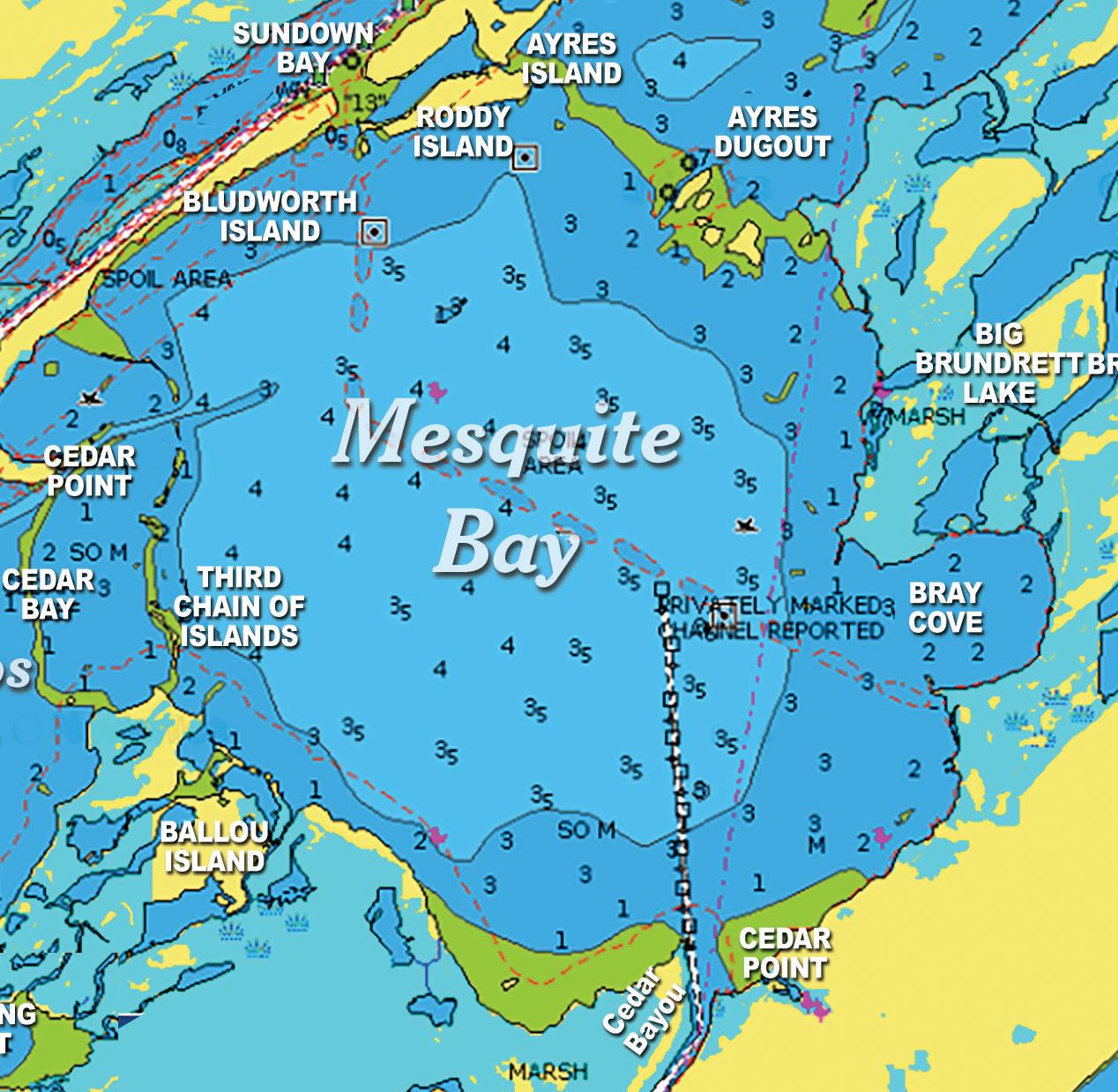
2
5
13 9
1
HOTSPOTLIGHT:
MESQUITE BAY
MESQUITE BAY IS west of St. Joseph Island, between Ayers Bay and Carlos Bay, principally in Aransas County It may be entered from the Gulf of Mexico through Cedar Bayou, a cut between St. Joseph and Matagorda islands. Selected HOTSPOTS are shown in the table below, and on the map.
SPECKLED TROUT
KEY HOTSPOT NAME GPS BEST BAIT & TACTIC
1 Fish Camp Cove
N 28 10.118, W 96 49.183
Sink magarita Bull Minnows or Live croaker in holes; Feb-Aug; dawn-midday, dusk
2 Southeast Shore
N 28 09.655, W 96 49.242
Lime green topwaters, Corkys, croakers, work shell & mud; Feb-April; dawn-midday, dusk
3 North Cedar Bay
N 28 09.191, W 96 53.191
Pearl/chartreuse tops early, Corky, work shell and mud; Apr-Mar, Sep-Oct; morn-midday
4 Third Chain of Islands N 28 08.337, W 96 52.374
Live croaker, look for jump bait fi sh, wade waist-deep; May-Aug; dawn thru morning
5 Cedar Bayou Flats N 28 07.317, W 96 49.323 REDFISH
6 North Fish Camp
N 28 09.944, W 96 49.541
Work early with tops & plastics, midday use croaker; Mar-Oct; dawn thru midday
Live shrimp under pop-n cork, anchor, fi sh the shell; Sep-Dec; dawn thru midday
7 North Cedar Bay
N 28 09.191, W 96 53.191
Pearl/chartreuse topwaters, Corkys, work the shell/ mud; Apr-Mar, Sep-Oct; morn-midday
8 Bray Cove
N 28 08.465, W 96 48.270
Work tops early along shoreline, work Live bait later; Sep-Nov; dawn thru morn
9 Cedar Bayou Flats N 28 07.317, W 96 49.323 FLOUNDER
10 Ayers Dugout
N 28 09.952, W 96 50.054
11 Little Brundrett Lake N 28 08.565, W 96 48.584
12 Ballou Island Cut
N 28 07.453, W 96 51.809
Live mullet, crab, anchor/Drift, fi sh up against grass; Sep-Oct; dawn-morn, dusk
Mud minnows, shrimp tipped jig, work bottom slowly; Mar-May, Aug-Oct; avoid midday Work bottom grass fl ats, great night gigging w lights; Mar-May, Aug-Oct; avoid midday Drift mud minnow on bottom slowly, night gigging; Sep-Nov; dawn, night
13 Cedar Bayou
N 28 06.708, W 96 49.812
Finger mullet, Car. rig, cast down shoreline, drag bottom; May-Jun, Nov-Dec; dawn-morn
WADEFISHING
1 Conservancy Shoreline N 28 07.313, W 96 48.893
Reds, trout, a few fl ounder; clear water, pumpkin, chart plastics; December thru September
2 Cedar Flats
N 28 06.831,W 96 50.314
Redfi sh, trout & a few fl ounder; croaker, perch; December thru September
SOURCE: TEXAS LAKES & BAYSFISHING ATLAS 2020 situation under control. Use a rod that can toss big trout lures a long distance, but one that is subtle enough to telegraph the slightest bump.
ROCKPORT AREA
Reported by CAPT. MAC GABLE
WHAT DOESN’T KILL YOU makes you stronger.”
“Hard times don’t last, tough people do.” ese are phrases I o en heard growing up. “Most problems can be xed with a li le elbow grease and patience,” was another that echoed through my head as I looked out across Lynn Channel.
No this isn’t a secret water way in Texas, but a deep gorge in Southeast Alaska. My wife and I, being frequent visitors to the Frozen North state, found ourselves in a small cabin 30 miles deep in the Haines, Alaska State Forest.
Although it was not the plan, it became our refuge to wait out the craziness of the pandemic, the riots and the ongoing saga of the 2020 election. With Hurricane Harvey forever etched in our minds and hearts, we o en wondered why such calamities happen. We got our answer, never imagining we’d be living a feeling of déjà vu. In December we found ourselves in the throes of another community disaster.
Snow o en blankets Southeast Alaska. It did so in late November in Haines, giving way to the global warming trends now a ecting our planet the rst few days in December. More than 10 inches of rain fell in less than 24 hours, creating ooding and landslides the likes of which this community had never seen. As I looked out on a mountain called Mt. Riley, a 600-foot gash was cut from the top of the mountain to the Lynn Channel shoreline. e slide hit the channel with such force it created a tidal wave, wreaking havoc in its wake. Many homes were a ected and much like Harvey, the horrible question was “Where did the homes and people go that were wiped o the face of the earth?”. Many were thought to be missing. In the end two people lost their lives, forever buried in the deep sediment of Mt. Riley.
I had recently been recruited to work a
MIDDLE COAST
few days at a local Sport Shop, owned by the newly elected mayor because he heard about my background and thought I’d be a natural t. Having just retired, I really wasn’t interested in working again, especially on the other side of a retail counter, but the mayor was persistent, and I reluctantly agreed.
Lisa and I cried heart felt tears as we saw the fear and the confusion in the eyes of our neighbors, the same we’d experienced just a few years before in Rockport. Our instincts kicked in. We had been there and knew how to help.
As it turned out there were many slides in the area that day. e small Alaskan community was cut o from fuel oil and was running for who knew how long on a backup generator for emergency electricity. e slides cut o the ferries and barges that were the lifeline of this community. Water mains were severed. Although help was on the way, one night in the far north where temperatures can drop below zero could put many lives in de nite danger. e new mayor, doing his best, stated he didn’t have all the right answers. “Sometimes there are no right answers,” I told him, “but what is needed is leadership. Even if it’s not the perfect answer, the community will rally and make it the right answer.
“You are the leader this town needs. Go back to the basics—food, water, and warmth. It’s all any of us truly need in the short term, day to day.”
“No, minute to minute is more like it,” he replied.
What Lisa and I could give was hope, knowing there is a tomorrow. ose lost did not perish for no reason. Much like Rockport, the community was split on many (mostly political) issues. However—just like Rockport—those di erences were put aside, and people rolled up their sleeves and got to work. e outdoor men and women were the rst to step up; what was a hunting and shing hobby was being called upon to sustain life, and they delivered big time. Food was plentiful. Help from as far away as, yes, Texas was o ered. is Texan could not be prouder of the Lone Star State. Mostly I listened as folks came into the Sport Shop just to talk. I could share our story and tell them not only would Haines bounce back, but the community as a whole would be be er and stronger than ever before.
Much like this old salt, they one day would understand why it happened—to help our fellow man and woman, wherever that may be. is article is dedicated to those lost in the recent landslides and oods in our sister state of the far north, Alaska.
March and April are the months most anglers wait for. e access to bait, which has been rare all winter, can suddenly appear these two months, mostly in April, but over the last several years March has seen the availability of shrimp increase. A good tactic is to use live bait to locate the bite, then switch to so plastics, which can be phenomenal.
COPANO BAY: e mouth of Mission Bay is a go-to spot for black drum and some keeper reds. I like live shrimp under a popping cork. Adjacent Shell Bank Reef is a good spot for trout using a bubble cork and an imitation Berkley shrimp.
ST. CHARLES BAY: Indian Head Point is a good spot for trout. is area is a good wade spot with mixed sand and mud. Free-lined live shrimp are the ticket in new penny jerk shad. On high tide, Bergentine Creek is a good spot for reds. Finger mullet works best on a light Carolina rig.
If live mullet is not available, use cut mullet.
ARANSAS BAY: Half Moon Reef is a good spot for trout using a ra le cork and live shrimp. is area has some deep edges, and I like to start deep then work my way closer to the reef. Dri s down Traylor Island or via trolling motor is good for trout and reds. is area is a natural sh pass. e key here is patience. One can dri for half a mile and not get a bite, then within a 50-yard stretch, limit out. If croaker is available, this is a good spot to use them, otherwise use live shrimp free-lined.
CARLOS BAY: On colder days, Carlos Trench is a good spot for trout. I use shrimp on a free line weighted with a few split shots to get the bait down in the current.
MESQUITE BAY: e shoreline of Big Brundre Lake is a good spot for reds and a few ounders using live shrimp jigged across the bo om. Reds will knock the rod out of your hand here; ounders will usu-



CAPT. GABLE ContactUs@Fishgame.com
ally give you a slight tap. If you don’t set the hook, they often ingest the bait and bury up in the sand, leading some to believe they are hung up. If this happens draw the line tight and twang the line like a guitar string. Usually, the flounder will turn loose and attempt to swim off.
AYERS BAY: The area close to Second Chain Island is a good spot for reds using finger mullet free-lined. Let the mullet swim, and don’t reel in until you get a bite. This is a heavy shell area, and you can break off. The shoreline close to Ayers Point is a good wade for trout using a rattle cork and shrimp or free-lined croaker. Fish deeper than you think here and cast 360 degrees, moving slowly.
BANK BITE: In late March and April wades off Goose Island shoreline can produce some nice trout and reds. This area can be accessed via the park entrance off Park Road 13. It is paid access. The area holds some good fish, especially on late north wind days. I like a mixture of live shrimp and finger mullet. This area is good for bank anglers as well, using a light Carolina rig.
CORPUS CHRISTI BAY
Reported by JOEY FARAH
THE WINDS OF CHANGE from winter to spring will roar through many a day in March, here in the Corpus Christi area of the Coastal Bend. High winds will open up opportunities for fishermen to land big boxes of black drum and redfish.
Live shrimp will be available at most marinas and bait camps, and are your best bet for tight lines. Look towards the ICW, or Intracoastal canal for great action from an anchored boat. Fishing both the leeward and windward sides of the channel can be productive.
On the leeward side, quietly slide the boat up into the shallows carefully avoid disturbing the bottom, and anchor. Cast out toward deeper water then let the bait roll against the edge of the drop off with the current. Along the windy side, one must anchor out deep and cast to the current swept edge.
Look for abnormal changes in the channel and sandy spots along the drop off. Carolina rigs with OWNER #4 to #6 circle hooks, using a 1/4- to 3/4-ounce slide weight is your best set up. I use 30- to 40-pound mono leader.
Live shrimp works best. At times peeling live shrimp, threading it on the hook, then adding another shrimp hooked in the head produces a presentation that cannot be passed up.
Drifting the flats on windy days can be as fun as a rock and roll concert, and as rough! When the winds are pushing the boat along, boat noise is hidden in the waves and live shrimp under a popping cork stands as a Texas Fishing Tradition.
Match your drop to the depth of the water, keeping the bait just above the bottom. Different styles, cork sounds, length of drop, and colored beads may make a difference, so experiment. Deploying a drift sock or even a bucket on a rope can slow your drift down and make it easier to fish. Make grid patterns with your drifts searching for groups of gamefish. Avoid running the boat through the fishing area.
Live shrimp fishing in March and April is at its best. Target the shallow rock piles and oyster reefs of Baffin Bay and Nueces Bay for insane action.
The spring topwater bite is on fire as well as the use of soft plastics along the Coastal Bend’s bay systems. March holds a few calm days and weather patterns will improve greatly in April. These are the times to hunt massive sow trout with lures.
The Laguna Madre has miles of flats three to five inches deep. Probe the mixed sand pockets along the King Ranch shoreline. The spoil islands south of Bird Island will keep you in a great soft plastic bite for trout and redfish.
Color patterns may vary but throwing the three-inch DOA Cal Shad on a 1/4-ounce jig head will produce gamefish all month long. The topwater bite will be at a peak in April as we will be landing some of the biggest trout of the year in the land cut.
Using the trolling motor along the edge of the channel here produces insane explosions from spawning speckled trout. The south shore of Baffin Bay is a legendary place for wade fishermen to hunt the largest trout in the state with topwater plugs.
Come down to the Coastal Bend for a wide range of public access fishing as well. The Indian Point pier and Portland Causeway is a great place to start. Nighttime bottom fishing on the pier is a sure thing for black drum, and trout under the lights on live shrimp and soft plastic lures.
Wade the shallows along the back side of Padre Island starting at the Bird Island boat ramp inside the Padre Island National Seashore. March and April bring a festival of coastal fishing here. Head down for a visit and Get Wet!
CAPT. FARAH
MIDDLE COAST HOTSPOTS
LOCATION: Aransas Bay HOTSPOT: Mack Reef GPS: N 28 5.2279, W 96 58.6309 (28.0871, -96.9772)

SPECIES: Speckled Trout BEST BAITS: Soft Plastics with a 1/16 oz jig head SOURCE: Capt. Billie Kocian 361-688-8859 TIPS: The trout should be working over shell reefs in the bay. Color choice is determined by water quality.
LOCATION: Copano Bay HOTSPOT: Copano Reef GPS: N 28 6.0117, W 97 6.0067 (28.1002, -97.1001)
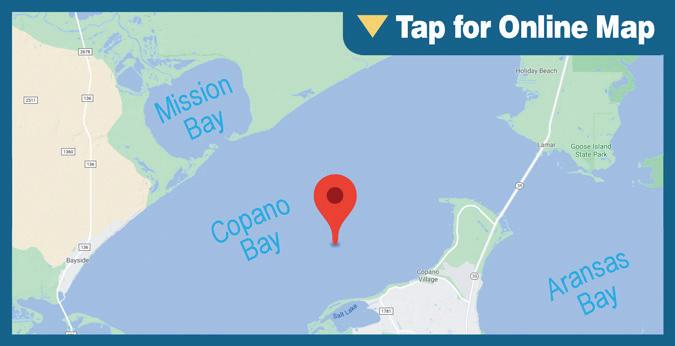
MIDDLE COAST
BEST BAITS: Cut menhaden and cut perch head, dead shrimp SOURCE: Capt. Garrett Frazier 409-354-3865 TIPS: With the cut perch head you have a good chance of picking up one or two nice size trout, just casting it along the bank where redfi sh like to concentrate.
LOCATION: Corpus Christi Bay HOTSPOT: Ingleside Cove GPS: N 27 50.3179, W 97 13.816 (27.8386, -97.2303)

SPECIES: Redfi sh BEST BAITS: Cut and live mullet SOURCE: Capt. Jack McPartland 361-290-6302 TIPS: Let the cut bait sit until a redfi sh decides to take it. Use a weight only to keep the live mullet from out of the pocket.
LOCATION: Mesquite Bay HOTSPOT: Cedar Bayou Flats GPS: N 28 7.0052, W 96 49.0053 (28.1168, -96.8168)

SPECIES: Redfi sh BEST BAITS: Cut menhaden and cut perch head, dead shrimp SOURCE: Capt. Garrett Frazier 409-354-3865 TIPS: Cedar Bayou provides a pretty good wade fi shing spot. The redfi sh are starting to migrate back into the bays, and usually we will catch some good limits wading the surf at Cedar Bayou.
LOCATION: Port Aransas HOTSPOT: Estes Flats GPS: N 27 56.541, W 97 5.944 (27.9424, -97.0991) SPECIES: Flounder BEST BAITS: Gigging SOURCE: Capt. Jack McPartland 361-290-6302 TIPS: At this time of the year, almost any shoreline on a channel should be holding fl ounder.



LOCATION: Port Aransas HOTSPOT: Lydia Ann GPS: N 27 52.218, W 97 2.883 (27.8703, -97.0481)
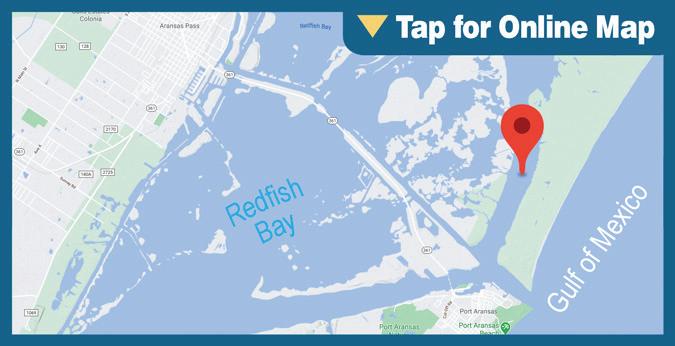
SPECIES: Flounder BEST BAITS: Gigging SOURCE: Capt. Jack McPartland 361-290-6302 TIPS: Tidal movement and moon phases can affect when to start gigging.
LOCATION: Port Aransas HOTSPOT: Outside Mud Island GPS: N 27 56.0139, W 97 1.0036 (27.9336, -97.0167) BEST BAITS: Cut menhaden and cut perch head, dead shrimp SOURCE: Capt. Garrett Frazier 409-354-3865 TIPS: Rigging: a 4/0 offset croaker hook…a drop rig. If you are fi shing with live bait, just hook it in the tail. Perch heads, hook it through the top part of the skull. When using menhaden, make sure it’s fresh… slime on it.
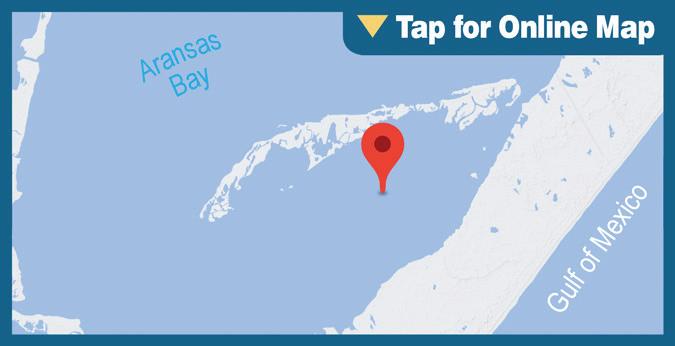
LOCATION: Port Lavaca HOTSPOT: Cadual Reef GPS: N 28 38.107, W 96 19.594 (28.6351, -96.3266)

SPECIES: Speckled Trout BEST BAITS: DOA Soft Plastics SOURCE: Capt. Van Critendon 361-648-1886 TIPS: Look for structure…reefs out in the middle of the bay, spoil banks.
LOCATION: Rockport HOTSPOT: Bay Oil Wells and Pads GPS: N 28 2.742, W 96 57.8339 (28.0457, -96.9639)

SPECIES: Speckled Trout BEST BAITS: Corkys or Soft Plastics SOURCE: Capt. Chad Verburgt 361-463-6545 TIPS: A Berkley Gulp in a pearl color also works great in the clearer water.
Fish Baffi n Now and Prepare to Be Amazed
BAFFIN BAY
FISHING BAFFIN BAY IN March and April can be amazing. e water temperature is starting to rise, and the sh are in a healthy, heavier condition as they begin to transition from a winter to a spring environment.
Reported by CAPT. GERAD MERRITT
Although there are many techniques to try, these have produced the most sh for me during this season. You can begin by walking through grass ats and nding the sandy pockets to work your lure in. It is important to remember; sight casting and shallow water shing are more about When I use live shrimp in Ba n Bay, I encounters. still tend to work drop-o s and rocks. e It is critical sh are slowly moving to more prominent to keep your structures, and you have to decipher what lure in the structures and part of the bay the sh are water as much feeding in for that particular day. If you as possible. don’t know precisely where a drop-o is When one or and don’t want to troll over it, you can pole
CAPT. MERRITT geradmerritt@gmail.com two sh see your lure and around and nd it. Another option that I have used in the don’t strike, past is casting out with a weight and feel for it is time to change the color options. One it to hit the bo om or structure. Try shing of my favorite choices is a simple silver or shallow to deep, and then deep to shallow, gold spoon. In my opinion, top waters can to get a sense whether or not the sh are be exciting and lead to endless possibilities moving to the shallow ats or coming out with the number of lure selections available of them. to anglers today. With these techniques and time of year,
Another great option is live bait. you’ll nd plenty of opportunities to catch During this season, the sh are feeding on a wide variety of saltwater sh that inhabit live shrimp, and they will soon switch to our bay system. I highly encourage anglers croaker. Using live shrimp under a popping of all ages to get outdoors. You never really cork can be an excellent indicator of any know what might await you on the other sh around. end of that hook.
Game sh, including black drum, do not discriminate against live shrimp, so each catch might be a surprise. Due to the use of the popping cork, your live shrimp may not stay as lively and active and may die a er several casts. Although the shrimp may have expired, you can continue to work it under the popping cork as long as you are mindful and do not jerk the shrimp o .
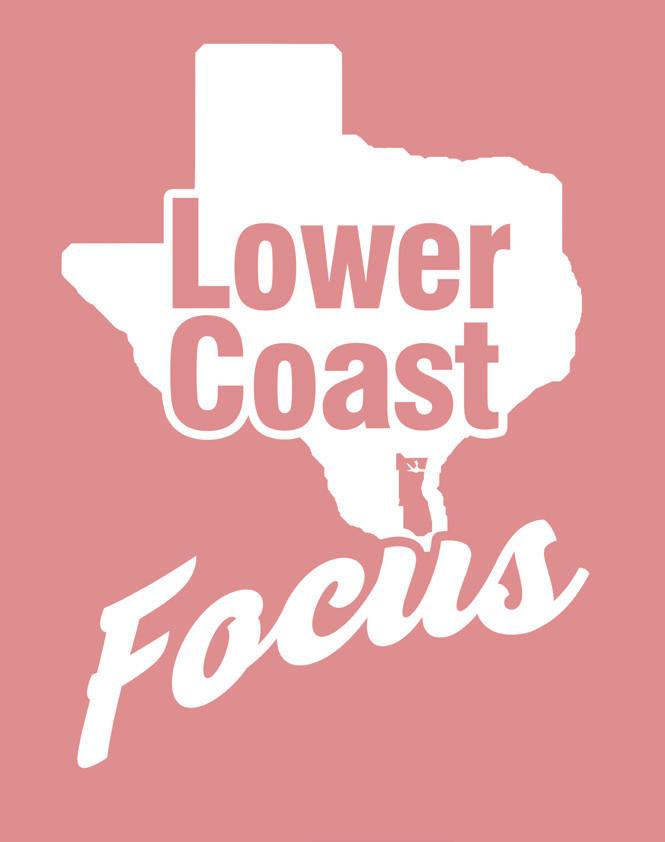


LOWER COAST HOTSPOTS
LOCATION: Arroyo Colorado HOTSPOT: East of Green Island GPS: N 26 23.5379, W 97 19.465 (26.3923, -97.3244)

SPECIES: Speckled Trout and Redfi sh BEST BAITS: 3-inch Berkley Gulp under a popping cork SOURCE: Capt. Joel Ramos 956-626-5143 TIPS: If the water is too fl at, I don’t spook the fi sh. Toss the cork out and barely pop it.
LOCATION: Baffi n Bay HOTSPOT: Black Bluff GPS: N 27 13.7029, W 97 31.8829 (27.2284, -97.5314)

SPECIES: Speckled trout BEST BAITS: Corky Fat Boy SOURCE: Capt. Tommy Countz 281-450-4037 TIPS: If the wind is out of the south, go over to the Kennedy side and work Los Coralles, Black Bluff and South Rocks.










